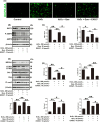Quercetin ameliorates oxidative stress-induced apoptosis of granulosa cells in dairy cow follicular cysts by activating autophagy via the SIRT1/ROS/AMPK signaling pathway
- PMID: 39232832
- PMCID: PMC11375867
- DOI: 10.1186/s40104-024-01078-5
Quercetin ameliorates oxidative stress-induced apoptosis of granulosa cells in dairy cow follicular cysts by activating autophagy via the SIRT1/ROS/AMPK signaling pathway
Abstract
Background: Follicular cysts contribute significantly to reproductive loss in high-yield dairy cows. This results from the death of follicular granulosa cells (GCs) caused by oxidative stress. Quercetin is known to have significant antioxidant and anti-apoptotic effects. However, the effect of quercetin on follicular cysts has yet been elucidated. Therefore, this study aimed to explore the anti-oxidant and anti-apoptosis effects and potential molecular mechanisms of quercetin in H2O2-induced primary cow GCs and 3-nitropropionic acid (3-NPA)-induced mouse model of oxidative stress and thus treat ovarian cysts in dairy cows.
Results: In this study, compared with estrus cows, cows with follicular cysts showed heightened levels of oxidative stress and increased follicular cell apoptosis, while autophagy levels were reduced. A model of oxidative stress was induced in vitro by H2O2 and showed significant increases in apoptosis together with reduced autophagy. These effects were significantly ameliorated by quercetin. Effects similar to those of quercetin were observed after treatment of cells with the reactive oxygen species (ROS) inhibitor N-acetylcysteine (NAC). Further investigations using chloroquine (autophagy inhibitor), rapamycin (autophagy activator), selisistat (SIRT1 inhibitor), and compound C (AMPK inhibitor) showed that chloroquine counteracted the effects of quercetin on oxidative stress-induced apoptosis, while rapamycin had the same effect as quercetin. In addition, the SIRT1/AMPK pathway inhibitors antagonized quercetin-mediated mitigation of the effects of oxidative stress on increased apoptosis and reduced autophagy. Consistent with the results in vitro, in mouse ovarian oxidative stress model induced by 3-NPA, quercetin activated autophagy through the SIRT1/AMPK signaling pathway, while alleviating oxidative stress damage and inhibiting apoptosis in mouse ovaries.
Conclusions: These findings indicate that quercetin can inhibit apoptosis in GCs and restore ovarian function by activating autophagy through the SIRT1/ROS/AMPK signaling pathway, suggesting a new direction for the treatment of ovarian follicular cysts in high-yield dairy cows.
Keywords: Apoptosis; Autophagy; Follicular cyst; Oxidative stress; Quercetin.
© 2024. The Author(s).
Conflict of interest statement
The authors declare that they have no conflict of interest.
Figures







Similar articles
-
Effects of exogenous spermidine on autophagy and antioxidant capacity in ovaries and granulosa cells of Sichuan white geese.J Anim Sci. 2023 Jan 3;101:skad301. doi: 10.1093/jas/skad301. J Anim Sci. 2023. PMID: 37698248 Free PMC article.
-
The mechanism of curcumin to protect mouse ovaries from oxidative damage by regulating AMPK/mTOR mediated autophagy.Phytomedicine. 2024 Jun;128:155468. doi: 10.1016/j.phymed.2024.155468. Epub 2024 Feb 24. Phytomedicine. 2024. PMID: 38471315
-
Resveratrol Attenuates Hydrogen Peroxide-induced Injury of Rat Ovarian Granulosa-lutein Cells by Resisting Oxidative Stress via the SIRT1/Nrf2/ARE Signaling Pathway.Curr Pharm Des. 2023;29(12):947-956. doi: 10.2174/1381612829666230403133322. Curr Pharm Des. 2023. PMID: 37013424
-
Unraveling the AMPK-SIRT1-FOXO Pathway: The In-Depth Analysis and Breakthrough Prospects of Oxidative Stress-Induced Diseases.Antioxidants (Basel). 2025 Jan 9;14(1):70. doi: 10.3390/antiox14010070. Antioxidants (Basel). 2025. PMID: 39857404 Free PMC article. Review.
-
Therapeutic effects of quercetin in oral cancer therapy: a systematic review of preclinical evidence focused on oxidative damage, apoptosis and anti-metastasis.Cancer Cell Int. 2025 Feb 24;25(1):66. doi: 10.1186/s12935-025-03694-1. Cancer Cell Int. 2025. PMID: 39994659 Free PMC article. Review.
Cited by
-
Bioactivity and biomedical applications of pomegranate peel extract: a comprehensive review.Front Pharmacol. 2025 Mar 26;16:1569141. doi: 10.3389/fphar.2025.1569141. eCollection 2025. Front Pharmacol. 2025. PMID: 40206073 Free PMC article. Review.
-
Research Progress on the Interaction Between SIRT1 and Mitochondrial Biochemistry in the Aging of the Reproductive System.Biology (Basel). 2025 Jun 2;14(6):643. doi: 10.3390/biology14060643. Biology (Basel). 2025. PMID: 40563894 Free PMC article. Review.
-
Rutin Ameliorates BHBA-Induced Inflammation and Lipid Accumulation in Calf Hepatocytes Through NF-κB Signaling Pathway.Curr Issues Mol Biol. 2025 Apr 14;47(4):274. doi: 10.3390/cimb47040274. Curr Issues Mol Biol. 2025. PMID: 40699673 Free PMC article.
-
Targeting novel regulated cell death: disulfidptosis in cancer immunotherapy with immune checkpoint inhibitors.Biomark Res. 2025 Feb 26;13(1):35. doi: 10.1186/s40364-025-00748-4. Biomark Res. 2025. PMID: 40012016 Free PMC article. Review.
References
-
- Bijmholt S, Müller K, Leiding C, Hoedemaker M, Bollwein H, Kaske M. Lactational incidences of production diseases in German Fleckvieh cows of six Bavarian dairy farms. Tierarztliche Praxis Ausgabe G. 2012;40(6):347–58. - PubMed
LinkOut - more resources
Full Text Sources

